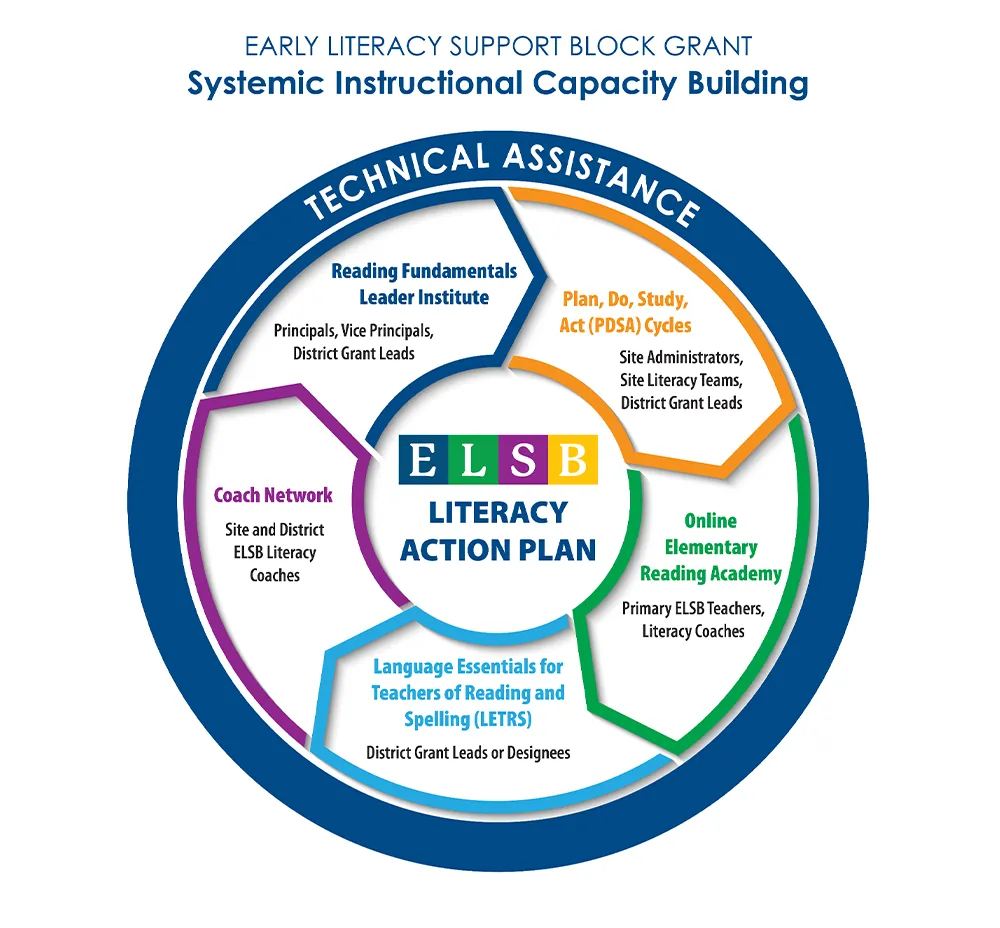
By Becky Sullivan
Improving literacy rates through systemic instructional capacity building
he Sacramento County Office of Education’s (SCOE) journey to improve literacy rates in California is a compelling story of coherent systemic change, collaboration and evidence-based intervention that began in December 2020 and extends into the present.
This narrative unfolds against the backdrop of the Early Literacy Support Block (ELSB) grant, a program aimed at addressing the state’s lowest-performing schools’ literacy rates and among students in the most challenging circumstances.
The catalyst for this initiative was a lawsuit filed on behalf of California students who struggled with reading, leading to the allocation of $50 million to establish the ELSB grant. SCOE was chosen through a competitive grant process to lead this effort, targeting 75 schools with the lowest performance in English language arts as identified in 2019. The ambition was not just to improve literacy but to enact systemic change that addressed the root causes of low literacy rates. Working closely with each school, SCOE developed a coherence framework to help recognize the interdependence of its culture, systems and structures, resources, stakeholder relationships and environment. This understanding of how these various aspects reinforce one another brought clarity to supporting the implementation of an improvement strategy.

Central to SCOE’s strategy was the development of Literacy Action Plans tailored to the unique needs of each participating site. These plans were informed by a thorough needs assessment and root cause analysis and focused on four critical areas: access to high-quality literacy teaching, support for literacy learning, pupil supports, and family and community support. Collaboration with Pivot Learning (Pivot), the Consortium on Reaching Excellence (CORE) and Lexia Learning ensured that the professional learning was grounded in the latest research and best practices in literacy education. The Literacy Action Plans were key to the accountability of the project, while allowing for local context and flexibility. Sites chose literacy goals and then were required to choose one or more of the following categories as a part of the plan:
- Access to high-quality literacy teaching: Including and not limited to the use of coaches, bilingual reading specialists, instructional aides/paraprofessionals, culturally responsive curriculum and evidence-based professional learning.
- Support for literacy learning: Including and not limited to the purchase of curriculum resources and instructional materials, professional development to support the implementation of the materials and/or diagnostic assessment instruments.
- Pupil supports: Including and not limited to expanded learning programs to improve access to literacy instruction, library models to expand literacy access and instruction, strategies to improve school climate, strategies to implement social-emotional learning approaches and expanded access to the library.
- Family and community support: Including and not limited to the development of trauma-informed practices and supports, provision of mental health resources, strategies to implement Multi-Tiered Systems of Supports (MTSS) and response to intervention, literacy training for parents and strategies to improve parent and community engagement.
SCOE hosted a series of professional development sessions that were both demanding in scope and innovative in delivery, leveraging virtual platforms to reach educators across the state. These sessions were not just about imparting knowledge but also about fostering a shared language and understanding of evidence-based practices in literacy education, particularly those informed by the science of reading.
Participants were encouraged to bring screening data to the root cause analysis session, using insights to identify key needs. The approach emphasized personal agency, avoiding blame and keeping the focus on actionable areas. This period also facilitated partnerships between ELSB schools for sharing and feedback. Efforts culminated in the development of Literacy Action Plans, with final submissions reviewed by cross-agency teams including the California Department of Education, the State Board of Education, the California Collaborative for Educational Excellence, Pivot, CORE and SCOE, ensuring thorough communication and allowing for necessary revisions. All submitted plans were approved, reflecting the comprehensive and collaborative nature of this initiative.
SCOE led the mission to enhance systemic instructional capacity with a steadfast focus on literacy. The comprehensive approach aimed to create a unified framework for literacy education across the targeted schools.
Key components included:
- Monthly administrator training: Delivered by CORE to ensure leadership alignment and support for literacy initiatives.
- Language Essentials for Teachers of Reading and Spelling (LETRS): A two-year course offered by Lexia Learning for grant leads, focusing on literacy and language development.
- Monthly coach network: Facilitated by SCOE to foster a community of practice among literacy coaches and support for implementing Literacy Action Plans.
- CORE’s Online Elementary Reading Academy: Provided for teachers to deepen their understanding and skills in effective literacy instruction.
- Plan-Do-Study-Act cycles: Conducted six times a year with site literacy teams to evaluate their data and refine Literacy Action Plans continuously.
SCOE’s support extended beyond professional development to include weekly office hours, phone calls and emails, ensuring each site received tailored technical assistance. This endeavor was part of a broader commitment to California’s System of Support.

SCOE’s journey illustrates the power of strategic leadership, collaborative partnerships and a relentless focus on evidence-based practices in transforming educational outcomes. Furthermore, the adherence to a coherence framework rather than mismatched strategies created accountability and was pivotal for school leaders in building a collective purpose with focused direction. The model also cultivated a collaborative culture and helped to clarify the roles for individuals and teams. The partnerships formed through SCOE provided deepened learning, which resulted in accelerated improvement and fostered innovation.